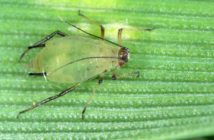Crop Management Partners agronomist Tristan Gibbs is well accustomed to dealing with yellow rust in his area of Kent and East Sussex.
Although the breakdown of the Yr15 gene is concerning, he points out that we have been in this position before, where varieties have quickly succumbed to the disease. He also points out that we’ve been managing susceptible yellow rust varieties successfully for several seasons. “Many growers have stuck with Skyfall and Zyatt despite their susceptibility. What’s important isn’t so much their vulnerability but how they are managed.”
For him, staying ahead of the disease is key. “We still have an effective armoury to choose from, including products with some kickback like tebuconazole.”
He advises inserting products like tebuconazole and azoxystrobin into programmes, especially as these are inexpensive fungicide options, adding little to the overall programme cost. “Many fungicides offer respectable performance against the disease, adding a long-lasting azole or a strob can boost protection further and offer some curative activity if needed.
“With the yellow rust threat high in my area, I’m kicking programmes off with tebuconazole at the T0 and coming back in with a strob at T1. Typically, the gap is short and it is about boosting protection.
“I’m also coming back in at the T2 with a second tebuconazole. The danger here can be leaf 2, which is left exposed between T1 and T2, especially if the application gets stretched. “Although it may look clean, symptoms are still to express, so topping up with something like tebuconazole is an inexpensive insurance against an unexpected ‘firefighting’ situation.”
‘When thinking about 25/26 variety choices, Niab’s Dr Aoife O’ Driscoll doesn’t feel growers should be too heavily influenced by this season’s yellow rust outbreak.
She points out that Skyfall and KWS Zyatt have performed well over several seasons despite their susceptibility to the disease. ‘’Growers and agronomists recognise that yellow rust is their weakness, so take steps to manage it appropriately.
“Key with any variety is knowing its susceptibility, it is then a case of responding accordingly. Many fungicides have good yellow rust activity, especially azoles with good knockdown like tebuconazole and the strobilurins, which provide longer lasting protection. It’s essential to get on top of the disease early, so if active yellow rust is present at GS30, an effective T0 is always advisable, and then backing it up with a product with good yellow rust activity at T1.”
For AICC president Patrick Stephenson, he describes the 24/25 season as “a real challenge” in the north with Champion, Beowulf and Typhoon being badly affected, and Bamford and Dawsum were not far behind.
He believes these appear to have a major reliance on the Yr15 gene, the problem he expects these varieties would have been a major part of drilling for the coming season. He is encouraging growers to adopt some diversification in variety choices this season when it comes to yellow rust.
In his view, new varieties Hexton and Arnie appear to be reasonably robust, and older varieties Extase, Graham, and Zealum also held up well. Blends are an option but care needs to be given to pick the right combination to alleviate the worst of any specific disease risk.
Furthermore, disease threats often evolve through the season, so a switch in variety or move to a blend needs to offer some protection against a range of pathogen threats. Septoria is the key threat in his area, changing variety can be like jumping from one boiling pan into another.
Easier spraying season
He agrees that there is a decent fungicide armoury but stresses the importance of application timing. “From a spraying perspective, last season was easy. This will not always be the case. Many in my area are thankful that we still have tebuconazole and therefore do not have a problem, but this assumes it can be applied on time.”
It is a point echoed by agronomist Luke Bullock. He worries that bad weather could impair T0 and T1 applications. Should that be the case, then it is likely to mean remedial action, increasing input spend further.




